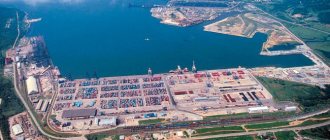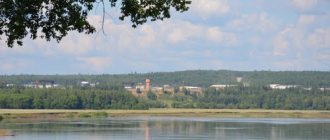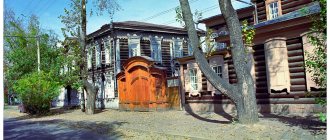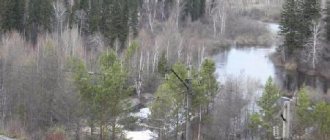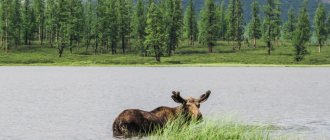Geography
The city is located on the Uda River (the left tributary of the Angara, the Yenisei basin), 506 km from Irkutsk. Named to distinguish it from the one formed at the mouth of another river. Uda (right tributary of the Selenga) of the city of Verkhneudinsk (now Ulan-Ude).
18 km from Nizhneudinsk, downstream of the river. Uda, there is the Ukovsky waterfall, height 20 m.
75 km up the Uda River, south of Nizhneudinsk, at an altitude of about 460 m above river level, are the Nizhneudinsk caves.
In the Nizhneudinsky district, 209 km from Nizhneudinsk, there is the Tofalaria area, where the Tofalars (Tofs) live, one of the smallest ethnic groups in Russia.
Nizhneudinsk
(Irkutsk region)
OKATO code:
25228501
Founded:
1648
City since:
1783 City of district subordination (Nizhneudinsky district of the Irkutsk region)
Center:
Nizhneudinsky district
Telephone code (reference phone)
| 39517***** | — |
Deviation from Moscow time, hours:
5
Geographic latitude:
54°54′
Geographic longitude:
99°01′
Altitude above sea level, meters:
410 Sunrise and sunset times of the Sun and Moon in the city of Nizhneudinsk
Transport accessibility
- Station of the East Siberian Railway,
- Federal highway R-255 “Siberia”,
- Airport "Nizhneudinsk".
The main mode of transport is railway. In 2004, the reconstruction of the locomotive depot and railway station was completed.
Air transportation is carried out by Nizhneudinsk Aviation Enterprise OJSC. In 2010, after a bankruptcy procedure, the company was purchased by IrkutskAvia, which in 2011 merged with the Angara airline.
Distance from Nizhneudinsk to some cities, km
| City | Distance | |
| Alzamay | 92 | 90 |
| Tulun | 117 | 123 |
| Taishet | 163 | 157 |
| Winter | 256 | 256 |
| Cheremkhovo | 276 | 373 |
| Vikhorevka | 432 | 327 |
| Usolye-Sibirskoye | 439 | 446 |
| Bratsk | 456* | 348 |
| Angarsk | 467 | 477 |
| Irkutsk | 506 | 521 |
| Shelekhov | 526 | 539 |
| Krasnoyarsk | 581 | 526 |
| Slyudyanka | 632 | 633 |
| Zheleznogorsk-Ilimsky | 718 | 609 |
| Ust-Kut | 886** | 717 |
| Ust-Ilimsk | 953 | 608 |
| Ulan-Ude | 1054 | 971 |
*To Anzebi station.
**To Lena station.
They fought for their homeland
Dmitry Matveevich was born on January 2, 1920 into a large peasant family. Childhood coincided with the hungry years. From an early age, Dmitry Matveevich loved to work and was fond of sports. From the age of eleven he worked on a collective farm as a plowman, and then became a tractor driver. “Right on the train where I was working on a tractor, I was given a summons to enlist in the Red Army,” said the veteran, recalling the years of the Great Patriotic War. “Wherever I fought, I always thought about my native country, about my village, about my fellow villagers.” The parents did not want to let their son go to war, but Dmitry Matveevich proudly went to fight and defend his homeland from the invaders..
Read
Population
Population by year
| 1856 | 1897 | 1926 | 1931 | 1959 | 1967 | 1970 | 1979 | 1989 | 1992 |
| 2400 | 5800 | 10 400 | 10 900 | 38 761 | 38 000 | 39 743 | 41 399 | 43 759 | 44 000 |
| 1996 | 1998 | 2000 | 2001 | 2002 | 2003 | 2005 | 2006 | 2007 | 2008 |
| 44 000 | 43 200 | 42 500 | 42 300 | 39 624 | 39 600 | 38 800 | 38 400 | 37 800 | 37 400 |
| 2009 | 2010 | 2011 | 2012 | 2013 | 2014 | 2015 | 2016 | 2017 | 2018 |
| 37 090 | 36 999 | 36 881 | 36 326 | 35 500 | 34 813 | 34 235 | 34 049 | 33 954 | 33 918 |
| 2019 | 2020 | ||||||||
| 33 971 | 33 616 |
Climate
Nizhneudinsk has a subarctic climate (Köppen climate classification Dwc
), with long, severely cold winters and short, warm summers. Precipitation is quite low, but in summer it is much higher than at other times of the year.
| Climate data for Nizhneudinsk | |||||||||||||
| Month | Jan | Feb | Mar | Apr | May | Jun | Jul | Aug | Sep | October | But I | December | Year |
| Record high °C (°F) | 8.0 (46.4) | 12.9 (55.2) | 19.4 (66.9) | 30.5 (86.9) | 34.0 (93.2) | 36.3 (97.3) | 35.4 (95.7) | 36.4 (97.5) | 31.7 (89.1) | 26.9 (80.4) | 16.3 (61.3) | 10.4 (50.7) | 36.4 (97.5) |
| Average high °C (°F) | −13.5 (7.7) | −7.6 (18.3) | 0.9 (33.6) | 9.1 (48.4) | 17.9 (64.2) | 22.8 (73.0) | 25.0 (77.0) | 22.2 (72.0) | 15.4 (59.7) | 7.0 (44.6) | −3.6 (25.5) | −11.8 (10.8) | 7.0 (44.6) |
| Daily average °C (°F) | −20.6 (−5.1) | −16.6 (2.1) | −7.5 (18.5) | 1.6 (34.9) | 9.4 (48.9) | 15.0 (59.0) | 17.9 (64.2) | 15.1 (59.2) | 8.1 (46.6) | 0.5 (32.9) | −9.3 (15.3) | −17.8 (0.0) | −0.4 (31.4) |
| Average low °C (°F) | −26.1 (−15.0) | −23.8 (−10.8) | −14.9 (5.2) | −4.6 (23.7) | 1.8 (35.2) | 8.1 (46.6) | 11.7 (53.1) | 9.4 (48.9) | 2.9 (37.2) | −4.1 (24.6) | −13.8 (7.2) | −22.7 (−8.9) | −6.3 (20.6) |
| Record low °C (°F) | −49.7 (−57.5) | −47.5 (−53.5) | −45.2 (−49.4) | −32.0 (−25.6) | −11.6 (11.1) | −4.5 (23.9) | −0.8 (30.6) | −2.6 (27.3) | −9.6 (14.7) | −27.5 (−17.5) | −42.6 (−44.7) | −49.6 (−57.3) | −49.7 (−57.5) |
| Average precipitation mm (inches) | 10 (0.4) | 7 (0.3) | 8 (0.3) | 19 (0.7) | 32 (1.3) | 60 (2.4) | 89 (3.5) | 90 (3.5) | 48 (1.9) | 21 (0.8) | 14 (0.6) | 13 (0.5) | 411 (16.2) |
| Average snowfall, cm (inches) | 19 (7.5) | 20 (7.9) | 13 (5.1) | 1 (0.4) | 0 (0) | 0 (0) | 0 (0) | 0 (0) | 0 (0) | 1 (0.4) | 7 (2.8) | 15 (5.9) | 76 (30) |
| Average number of days with precipitation (≥ 0.1 mm) | 17.1 | 15.1 | 15.3 | 18 | 19 | 20.1 | 18 | 20 | 19 | 19 | 20.3 | 19 | 219.9 |
| Average snow days | 17 | 15 | 14 | 8 | 2 | 0 | 0 | 0 | 1 | 8 | 18 | 19 | 102 |
| Average relative humidity (%) | 83 | 79 | 71 | 62 | 60 | 69 | 75 | 80 | 78 | 76 | 81 | 84 | 75 |
| Source: Pogoda.ru.net[13] | |||||||||||||
Economy
The city-forming basis of Nizhneudinsk is railway transport, whose contribution to the city’s economy exceeds 60%. Almost every fifth able-bodied resident of Nizhneudinsk works at industry enterprises.
Industry remains the second city-forming basis, but its contribution to the city economy has become less significant compared to the Soviet period. In pre-perestroika times, large enterprises successfully operated in Nizhneudinsk, such as one that produced container-type buildings, a road-building materials plant, a mica and furniture factory, a brewery, a meat processing plant, a confectionery factory, a dairy plant, a number of timber processing plants, etc. These enterprises produced more than 50 names of products that were well known far beyond the borders of the Irkutsk region. As of 2010, production remained in the logging, food and construction industries, with a predominance of forestry enterprises, which accounted for 70% of industrial production in 20103.
Industrial enterprises of the city: carriage repair plant, locomotive depot of the East Siberian Railway, Nizhneudinsk furniture factory, Nizhneudinsk bakery, confectionery factory, meat production.
In 2012, the average monthly salary of one employee in Nizhneudinsk was more than 25 thousand rubles. (in the Irkutsk region - just over 27 thousand rubles)4
"My city today and yesterday"
My parents and I often walk in the center of our city. Most of all I like to be in the Children's Park area; in the summer it is very beautiful on Lenin Street. I love to walk along the suspension bridge over Orlik, look at the ducks crowding here in huge numbers to feast on pieces of bread that passers-by throw from the bridge. I like to stop at the place where Orlik flows into the Oka, known to all Oryol residents as the Strelka, to admire the views of the city. After all, it was on this spot that back in 1566, on the orders of Tsar Ivan the Terrible, they began to build a wooden fortress, which was supposed to prevent uninvited guests from the southern steppes from attacking the Moscow state. And although settlements existed here before, it was from the founding of the fortress that the history of the city on the Orel River (the old name of Orlik) began.
Read
Natives and residents
- Barinov Boris Fedorovich - hockey coach.
- Goreglyad, Vladislav Nikanorovich - Japanese scholar.
- Erykalova, Yulia Nikolaevna - Hero of Socialist Labor, general practitioner.
- Kryuchkova, Tamara Aleksandrovna - historian, major specialist in icon painting, wooden sculpture, history of temple construction, spiritual life in Eastern Siberia.
- Rachkov, Mikhail Porfirievich - Doctor of Economic Sciences, Professor.
Story
On October 14, 1648, under the leadership of Ataman Elisey Tyumentsev, at the request of the prince of the Uda Buryats Oilanko (Ilanko), the Krasnoyarsk Cossacks founded the winter quarters of the Pokrovsky town on the right bank of the Uda River.
The following year, the Pokrovsky town was renamed the Udinsky fort, and in 1664 received the status of a fort.
In the summer of 1666 it was captured and plundered by the Bek of the Yenisei Kyrgyz, Irenek.
In 1783 it received the status of a county town.
During the First World War, a camp for prisoners of war was created in Nizhneudinsk. In the winter of 1915-1916, 2,200 prisoners of war were kept in the camp[3].
On February 1, 1963, Nizhneudinsk was classified as a city of regional subordination.
Notes
- Mutko demands the dismissal of the head of the Nizhneudinsky district for using equipment for personal purposes // TASS. 2022. July 7
- Nizhneudinsk mayor resigned // Kommersant. 2022. No. 123. July 16
- Nizhneudinsk // Vinokurov M.A., Sukhodolov A.P. Cities of the Irkutsk region
- Alexander Putov: We need to change the lives of Nizhneudin residents for the better // Regional newspaper. 2013. No. 112 (1133). October 7th.
Recommendations
Notes
- ^ a b
Charter of the Irkutsk region - ^ a b Register of administrative-territorial entities of the Irkutsk region
- ^ a b
Federal State Statistics Service of Russia (2011).
“All-Russian Population Census 2010. Volume 1" [All-Russian Population Census 2010, vol. 1]. All-Russian Population Census 2010 [All-Russian Population Census 2010]
(in Russian). Federal State Statistics Service. - "26. The size of the permanent population of the Russian Federation by municipalities as of January 1, 2022.” Federal State Statistics Service. Retrieved January 23, 2022.
- ^ a b
Law No. 49-OZ - ^ a b c d f
Law No. 86-oz. - "On the calculation of time." Official Internet portal of legal information
(in Russian). June 3, 2011. Retrieved January 19, 2022. - Post office. Information and computing center of OASU RPO. ( Post office
).
Search for postal facilities ( Search for postal facilities
) (in Russian) - Federal State Statistics Service of Russia (May 21, 2004). “The population of Russia, the constituent entities of the Russian Federation as part of federal districts, urban settlements, urban settlements, settlements, settlements is 3 thousand or more people” [Population of Russia, its federal districts, constituent entities of the federation, districts, urban settlements, rural settlements - administrative centers, rural settlements with a population of more than 3000 people] (XLS). All-Russian Population Census of 2002 [All-Russian Population Census of 2002]
(in Russian). - “All-Union Population Census of 1989. The current population of union and autonomous republics, autonomous regions and districts, territories, regions, urban settlements and rural district centers” [All-Union Population Census of 1989: current population of union and autonomous republics, autonomous regions and districts, territories, regions, districts, urban settlements and villages that are district administrative centers]. All-Union Population Census of 1989 [All-Union Population Census of 1989]
(in Russian).
Institute of Demography of the National Research University: Higher School of Economics [Institute of Demography of the National Research University: Higher School of Economics]. 1989 - via Demoscope weekly
. - https://promzona.org/utils/airfields.html?sort=&page=6&dir=asc Directory of Russian airfields Industrial zone
- "Archival copy." Archived from the original on May 13, 2008. Retrieved March 18, 2010.CS1 maint: archived copy as title (link)
- "Pogoda.ru.net - Climatic data for Nizhneudinsk 1981-2010." Retrieved January 23, 2013.
Sources
- Legislative Assembly of the Irkutsk Region. Resolution No. 9 / 5-ЗС dated April 15, 2009 “Charter of the Irkutsk Region”, as amended. Law No. 2-U of December 14, 2022 “On amendments to the Charter of the Irkutsk Region.” Came into force ten days after official publication. Published: “Regional”, No. 45, April 24, 2009 (Legislative Assembly of the Irkutsk Region. Resolution No. 9/5-ZS of April 15, 2009. Charter of the Irkutsk Region
As amended by the Law of December 14, 2022 No. 2-U.
On amendments to the Charter of the Irkutsk Region
... Valid from the day following the ten-day period after the day of official publication.). - Legislative Assembly of the Irkutsk Region. Law No. 49-OZ of June 21, 2010 “On the administrative-territorial structure of the Irkutsk region,” as amended. Law No. 12-OZ of March 23, 2022 “On amendments to Articles 25 and 33 of the Law of the Irkutsk Region” On the administrative-territorial structure of the Irkutsk region “and the Law of the Irkutsk Region” On the procedure for making changes to a geographical object and (or) on renaming geographical objects." Came into force after the official date of publication. Published: “Regional”, No. 71, June 25, 2010 (Legislative Assembly of the Irkutsk Region. Law No. 49-OZ of June 21, 2010 On the administrative-territorial structure of the Irkutsk Region
As amended by the Law of March 23, 2022 No. 12- OZ.
On amendments to Articles 25 and 33 of the Law of the Irkutsk Region “On the Administrative-Territorial Structure of the Irkutsk Region” and the Law of the Irkutsk Region “On the Procedure for Considering the Naming of Geographical Objects and (or) Renaming of Geographical Objects"
. Valid from the date of official publication. ) - Legislative Assembly of the Irkutsk Region. Law No. 86-oz of December 16, 2004 “On the status and boundaries of municipalities of the Nizhneudinsky district of the Irkutsk region.” Came into force on December 31, 2004, but not earlier than 10 days from the date of official publication. Published: “East Siberian Truth”, No. 254–255, December 20, 2004 (Legislative Assembly of the Irkutsk Region. Law No. 86-oz of December 16, 2004. On the status and boundaries of municipalities of the Nizhneudinsky district of the Irkutsk region
. Valid since 31 December 2004, but not earlier than 10 days after the official date of publication.). - Register of administrative-territorial entities of the Irkutsk region
(in Russian)
Natural resources
The Nizhneudinsky region has minerals unique in volume and quality: ore and placer gold, manganese, mica, coal, quartzites, dolerites, limestones and so on.
Significant timber reserves are concentrated in the region. The forest area is 4.6 million hectares with a total timber reserve of 575 million m3. The estimated cutting area is 1830.4 thousand m3, including 850 thousand m3 for coniferous farming. About 400 thousand m3 are developed annually.
Of the 22 coal deposits in the Irkutsk region, four deposits (Kaduiskoye, Mungunskoye, Katarbeyskoye and Ishideiskoye) are located in the Nizhneudinsky district with a total reserve of 1097.94 million tons or 13.9% of the reserves of the Irkutsk region.
The area of farmland in the Nizhneudinsky district is 67,742 hectares, the area of arable land is 57,066 hectares, hayfields are 4,562 hectares, and pastures are 61,114 hectares.
Diamond prospecting work in the Nizhneudinsky region remains feasible and relevant today. In the first half of the 50s, the Tanguy-Udinskaya area was involved, where in the valley of the Tanguy River, on a length of about 85 km. and in its tributary - Tarma, when testing alluvial deposits (6060 cubic meters), 137 diamonds with an average weight of 40.8 mg were discovered. (the largest is 485 mg), work in recent years has confirmed the presence of diamonds and their accompanying minerals.
